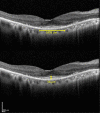Assessing Residual Cone Function in Retinitis Pigmentosa Patients
- PMID: 33364083
- PMCID: PMC7746956
- DOI: 10.1167/tvst.9.13.29
Assessing Residual Cone Function in Retinitis Pigmentosa Patients
Abstract
Purpose: The purpose of this study was to investigate cone function deterioration in patients with retinitis pigmentosa (RP) using full field electroretinogram (ffERG), pattern electroretinogram (pERG), and optical coherence tomography (OCT) and their correlation with visual acuity (VA).
Methods: Clinical records (2008-2018) of patients with RP undergoing repeat electrophysiology were reviewed. Results of ffERG (30 Hz flicker and fused flicker amplitude [FFAmp]), pERG [p50 and n95], and macular OCT (ellipsoid zone [EZ] and outer segment thickness) were collected.
Results: One hundred twenty-six eyes from 63 patients (33 women, mean age 35 years) were included. The mean decline in VA was 0.11 ± 0.14 logarithm of minimum angle of resolution (logMAR). The FFAmp decreased by 3.01 ± 5.9 µV with global cone function deteriorating by 18.7% annually. The percentage change in FFAmp (RE [r = 0.553], LE [r = 0.531]), and 30 Hz flicker amplitude (RE [r = 0.615], LE [r = 0.529]) strongly correlated with VA (P < 0.00001). The pERG p50 (15 and 30 degrees) change analyzed in 34 patients showed reduction by 23% and 23.4%, respectively. The percentage change in p50 30 degrees (r = 0.397) correlated with VA and EZ layer (P < 0.05). The EZ layer change was calculated in 45 patients and the shortening and thinning rate was 4.3% and 4.4% annually, respectively. The EZ length percentage change correlated with VA (RE [r = 0.34] and LE [r = 0.466; P < 0.05).
Conclusions: We quantified the decline in cone function in patients with RP utilizing ffERG and FFAmp measures of residual cone function. These parameters correlated with VA and OCT when measurable. These objective measures may assist in monitoring disease progression.
Translational relevance: Residual cone function provides an objective estimate of residual visual function, which aids in counselling patients regarding prognosis.
Keywords: OCT; electrophysiology; residual cone function; retinitis pigmenstosa.
Copyright 2020 The Authors.
Conflict of interest statement
Disclosure: T.A. Arsiwalla, None; E.E. Cornish, None; P.V. Nguyen, None; M. Korsakova, None; H. Ali, None; N. Saakova, None; C.L. Fraser, None; R.V. Jamieson, None; J.R. Grigg, Novartis (C)
Figures







Similar articles
-
Spectral-domain optical coherence tomography measures of outer segment layer progression in patients with X-linked retinitis pigmentosa.JAMA Ophthalmol. 2013 Sep;131(9):1143-50. doi: 10.1001/jamaophthalmol.2013.4160. JAMA Ophthalmol. 2013. PMID: 23828615 Free PMC article. Clinical Trial.
-
Assessing residual visual function in severe vision loss.Invest Ophthalmol Vis Sci. 2014 Mar 6;55(3):1332-8. doi: 10.1167/iovs.13-12657. Invest Ophthalmol Vis Sci. 2014. PMID: 24481260
-
Biomarkers in Usher syndrome: ultra-widefield fundus autofluorescence and optical coherence tomography findings and their correlation with visual acuity and electrophysiology findings.Doc Ophthalmol. 2020 Dec;141(3):205-215. doi: 10.1007/s10633-020-09765-0. Epub 2020 Apr 2. Doc Ophthalmol. 2020. PMID: 32240425
-
Quantification of Ellipsoid Zone Changes in Retinitis Pigmentosa Using en Face Spectral Domain-Optical Coherence Tomography.JAMA Ophthalmol. 2016 Jun 1;134(6):628-35. doi: 10.1001/jamaophthalmol.2016.0502. JAMA Ophthalmol. 2016. PMID: 27031504 Free PMC article. Clinical Trial.
-
Effects and Prognosis of Cataract Surgery in Patients with Retinitis Pigmentosa.Ophthalmol Ther. 2022 Dec;11(6):1975-1989. doi: 10.1007/s40123-022-00563-2. Epub 2022 Sep 4. Ophthalmol Ther. 2022. PMID: 36057888 Free PMC article. Review.
Cited by
-
The electroretinogram in the genomics era: outer retinal disorders.Eye (Lond). 2021 Sep;35(9):2406-2418. doi: 10.1038/s41433-021-01659-y. Epub 2021 Jul 7. Eye (Lond). 2021. PMID: 34234290 Free PMC article. Review.
-
Efficacy and safety of minocycline in retinitis pigmentosa: a prospective, open-label, single-arm trial.Signal Transduct Target Ther. 2024 Dec 4;9(1):339. doi: 10.1038/s41392-024-02037-2. Signal Transduct Target Ther. 2024. PMID: 39627217 Free PMC article. Clinical Trial.
-
Longitudinal Assessment of Structural and Functional Changes in Rod-cone Dystrophy: A 10-year Follow-up Study.Ophthalmol Sci. 2024 Nov 6;5(2):100649. doi: 10.1016/j.xops.2024.100649. eCollection 2025 Mar-Apr. Ophthalmol Sci. 2024. PMID: 39811267 Free PMC article.
-
Mutant mice with rod-specific VPS35 deletion exhibit retinal α-synuclein pathology-associated degeneration.Nat Commun. 2024 Jul 23;15(1):5970. doi: 10.1038/s41467-024-50189-0. Nat Commun. 2024. PMID: 39043666 Free PMC article.
-
A natural history study of autosomal dominant GUCY2D-associated cone-rod dystrophy.Doc Ophthalmol. 2023 Dec;147(3):189-201. doi: 10.1007/s10633-023-09954-7. Epub 2023 Sep 29. Doc Ophthalmol. 2023. PMID: 37775646 Free PMC article.
References
-
- Hartong DT, Berson EL, Dryja TP. Retinitis pigmentosa. Lancet. 2006; 368: 1795–1809. - PubMed
-
- Audo I, Holder GE, Moore AT. Retinitis pigmentosa and allied disorders. In: Puech B, De Laey JJ, Holder G. Inherited Chorioretinal Dystrophies. Berlin, Heidelberg: Springer;2014.
Publication types
MeSH terms
LinkOut - more resources
Full Text Sources
Research Materials

